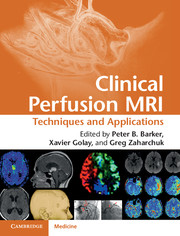Book contents
- Frontmatter
- Contents
- List of Contributors
- Foreword
- Preface
- List of Abbreviations
- Section 1 Techniques
- 1 Imaging of flow: basic principles
- 2 Dynamic susceptibility contrast MRI: acquisition and analysis techniques
- 3 Arterial spin labeling-MRI: acquisition and analysis techniques
- 4 DCE-MRI: acquisition and analysis techniques
- 5 Imaging of brain oxygenation
- 6 Vascular space occupancy (VASO) imaging of cerebral blood volume
- 7 MR perfusion imaging in neuroscience
- Section 2 Clinical applications
- Index
- References
1 - Imaging of flow: basic principles
from Section 1 - Techniques
Published online by Cambridge University Press: 05 May 2013
- Frontmatter
- Contents
- List of Contributors
- Foreword
- Preface
- List of Abbreviations
- Section 1 Techniques
- 1 Imaging of flow: basic principles
- 2 Dynamic susceptibility contrast MRI: acquisition and analysis techniques
- 3 Arterial spin labeling-MRI: acquisition and analysis techniques
- 4 DCE-MRI: acquisition and analysis techniques
- 5 Imaging of brain oxygenation
- 6 Vascular space occupancy (VASO) imaging of cerebral blood volume
- 7 MR perfusion imaging in neuroscience
- Section 2 Clinical applications
- Index
- References
Summary
Introduction
The flow of blood to an organ is a fundamental physiological factor affecting tissue health, growth, and repair. Blood flow and volume are perturbed in many disease conditions, most notably in vascular disease and in tumors. The ability to determine non-invasively blood flow and blood volume using imaging methods therefore has important diagnostic and therapeutic implications. Since the early days of radiological imaging, scientists and physicians have been searching for methods that can accurately and non-invasively depict the major blood vessels of the body, and measure blood flow in tissue. For instance, X-ray projection imaging of blood vessels (angiography) was first demonstrated in 1927 by Moniz [1], using iodinated contrast agents injected intravascularly, while early measurements of tissue blood flow were based on the inhalation of freely diffusible tracers (e.g., nitrous oxide [N2O] [2], or radioactive xenon or krypton [3]). Subsequently, stable (i.e., non-radioactive) xenon was used in conjunction with X-ray computed tomography (CT) to image cerebral blood flow (CBF) [4], while other methods such as single-photon emission CT (SPECT) [5, 6] and positron emission tomography (PET) [7, 8] imaging using a variety of radiotracers also became available. More recently, dynamic CT perfusion imaging using bolus injection of iodinated contrast agents has been growing in popularity [9], particularly as fast multi-slice CT scanners have become widely available.
- Type
- Chapter
- Information
- Clinical Perfusion MRITechniques and Applications, pp. 1 - 15Publisher: Cambridge University PressPrint publication year: 2013
References
- 1
- Cited by



